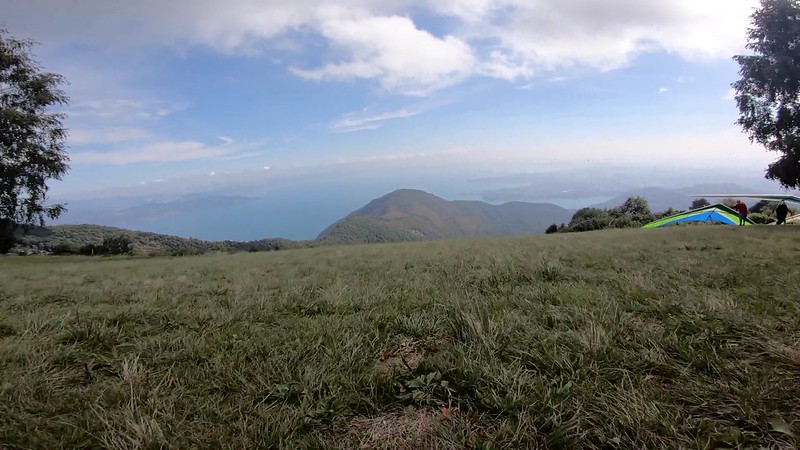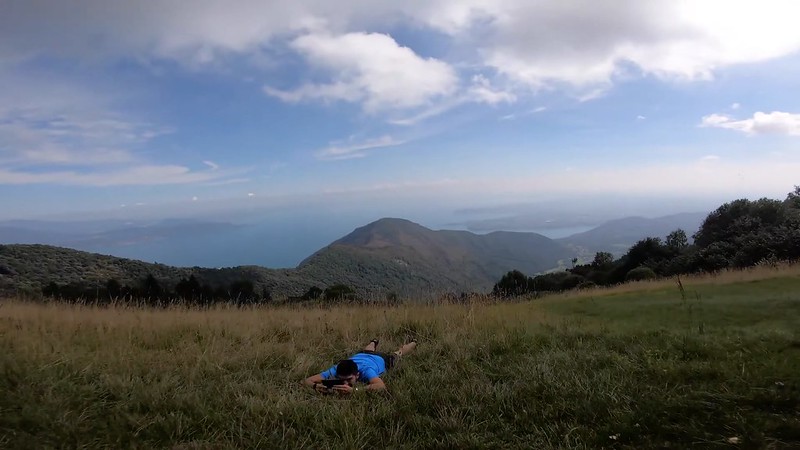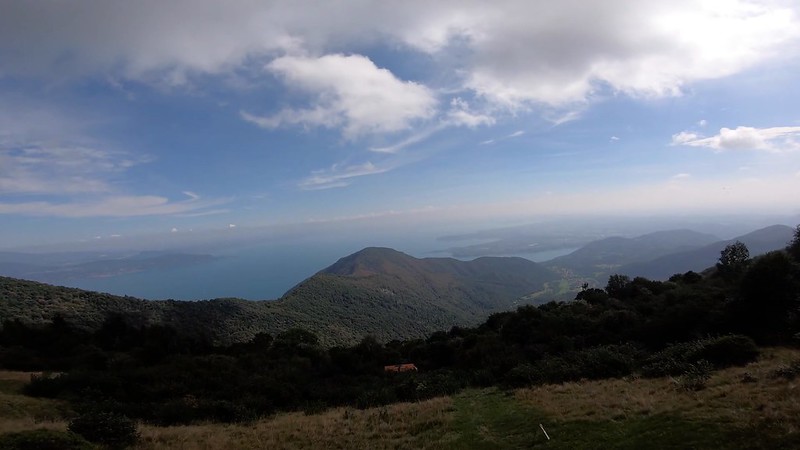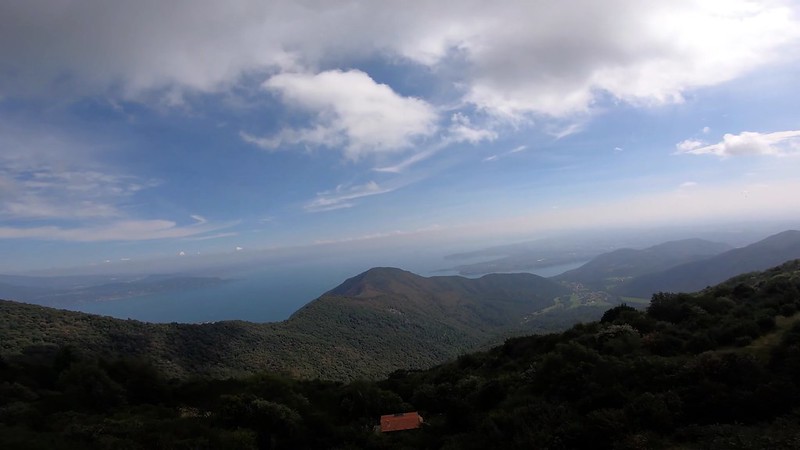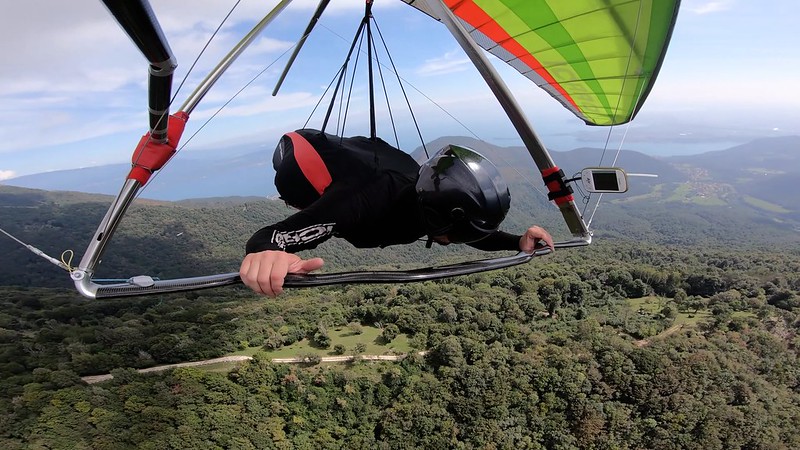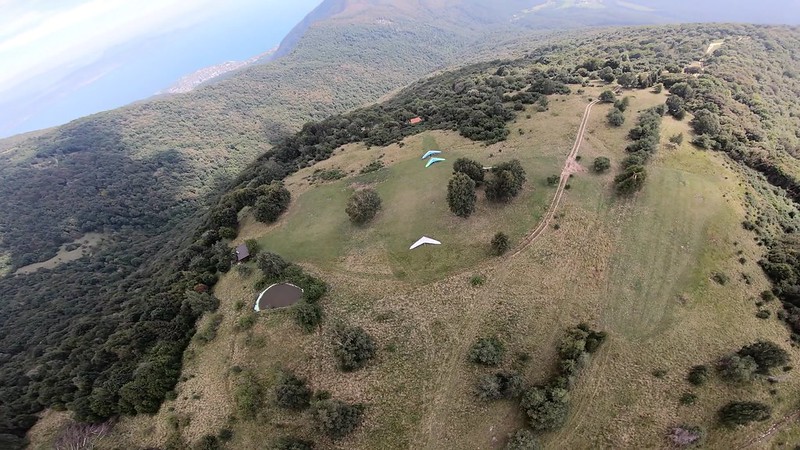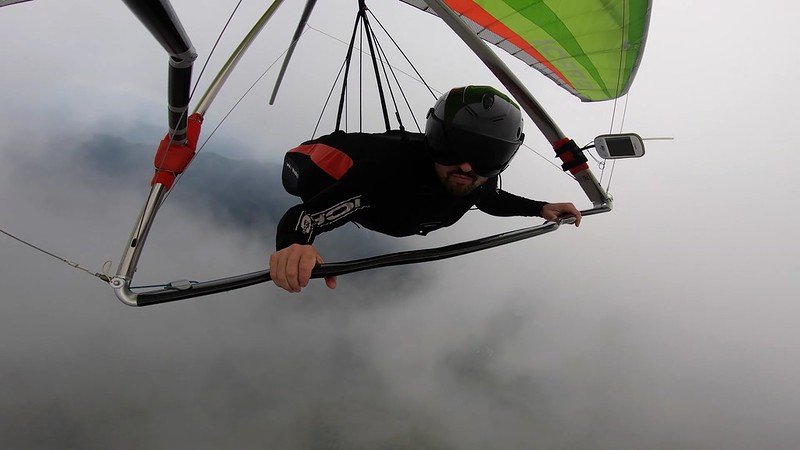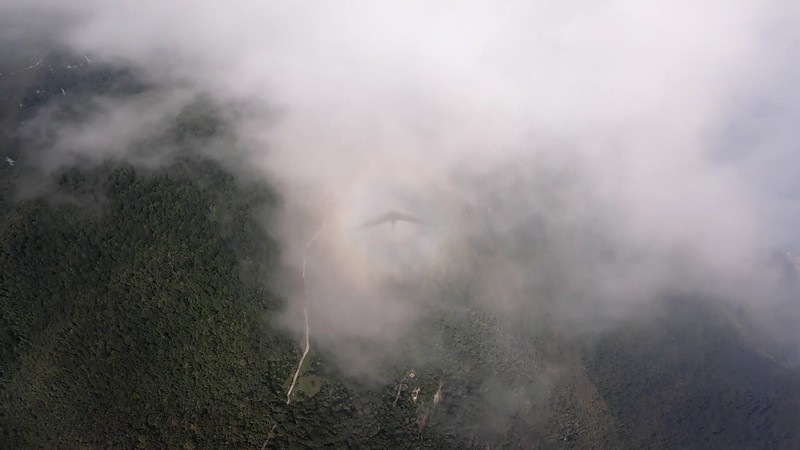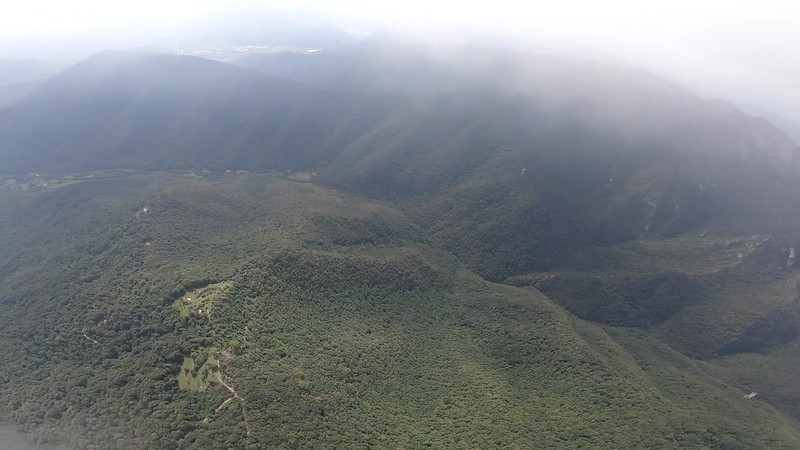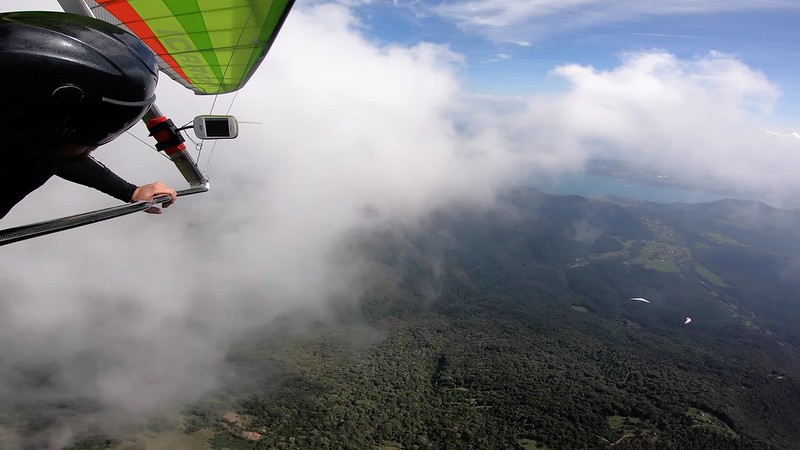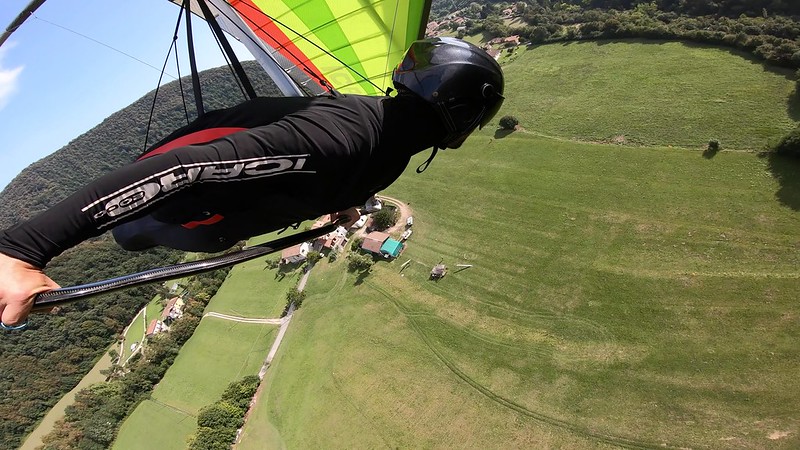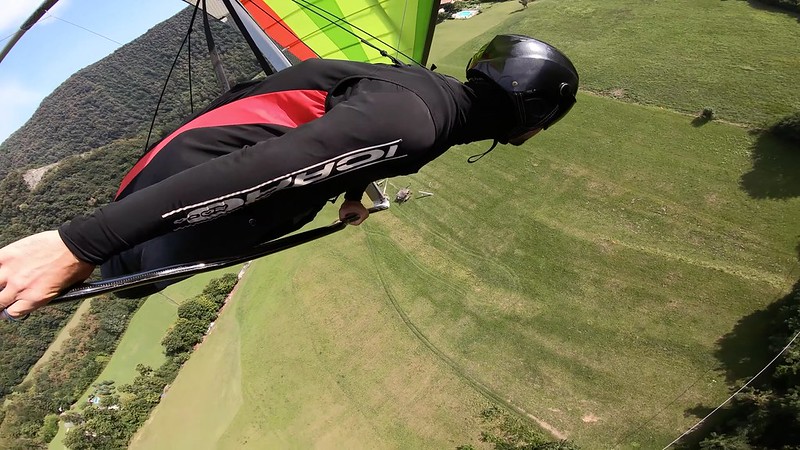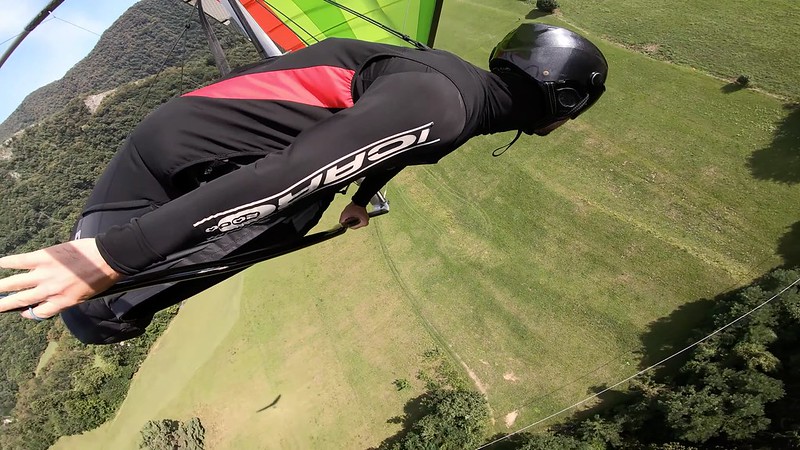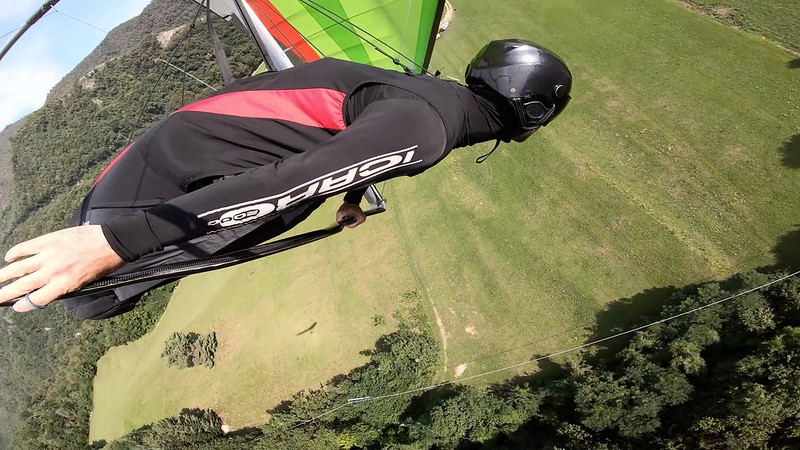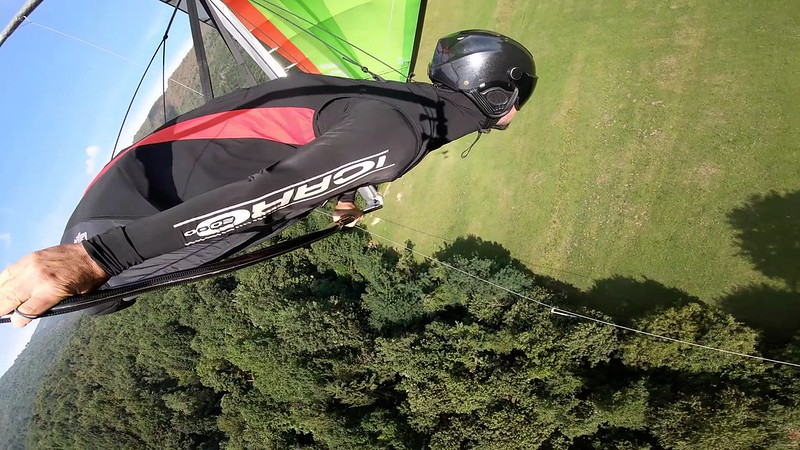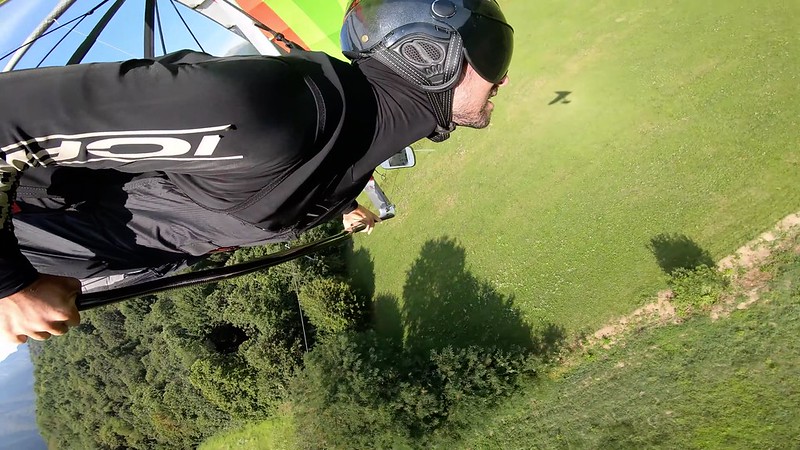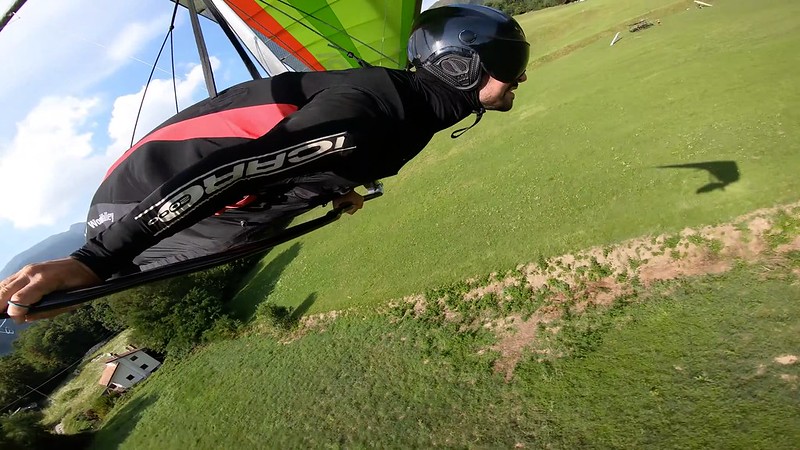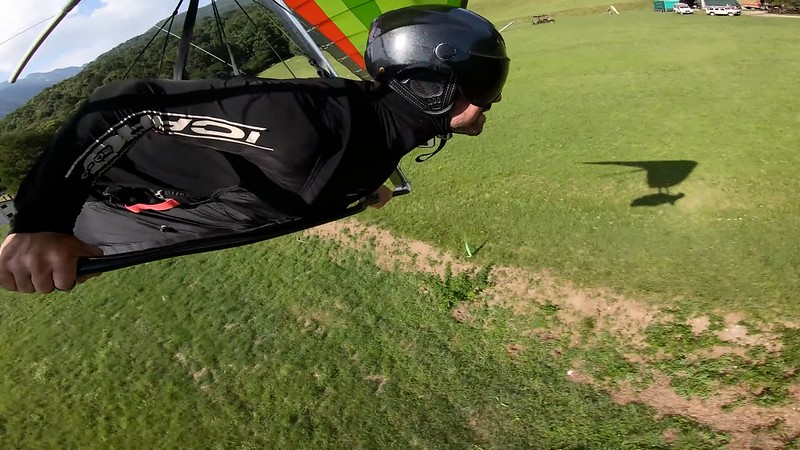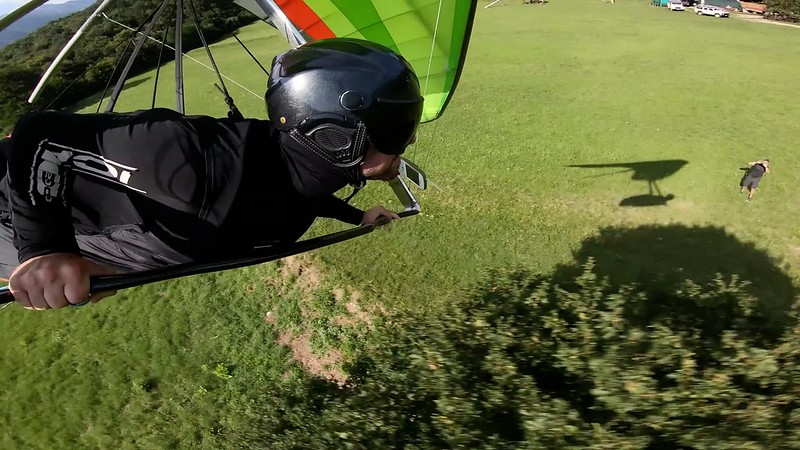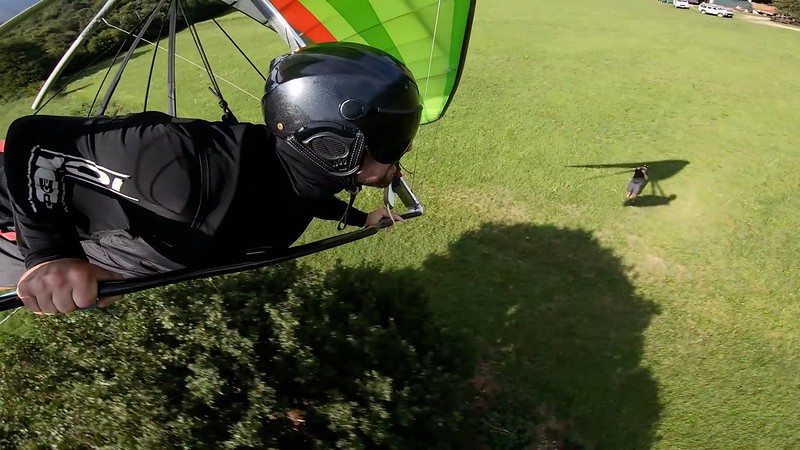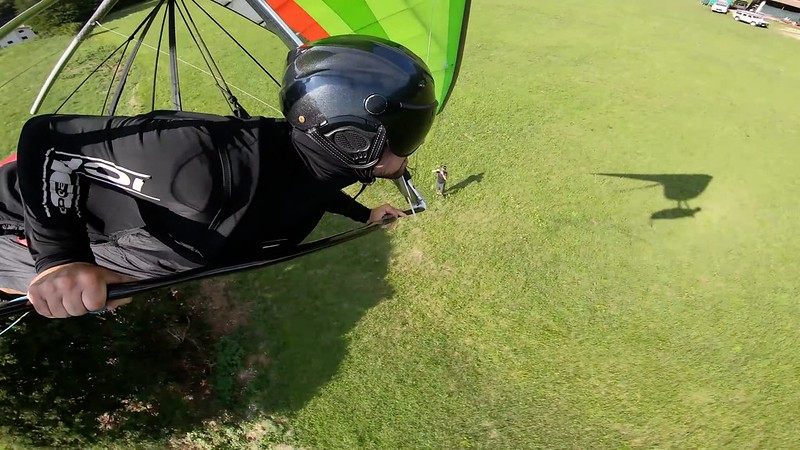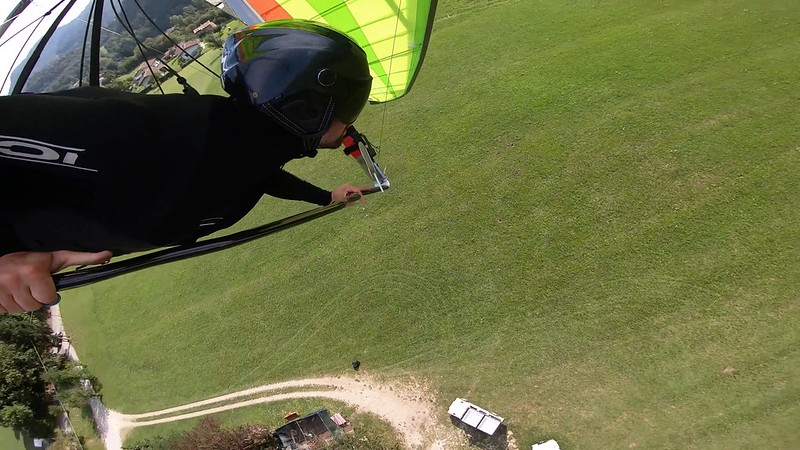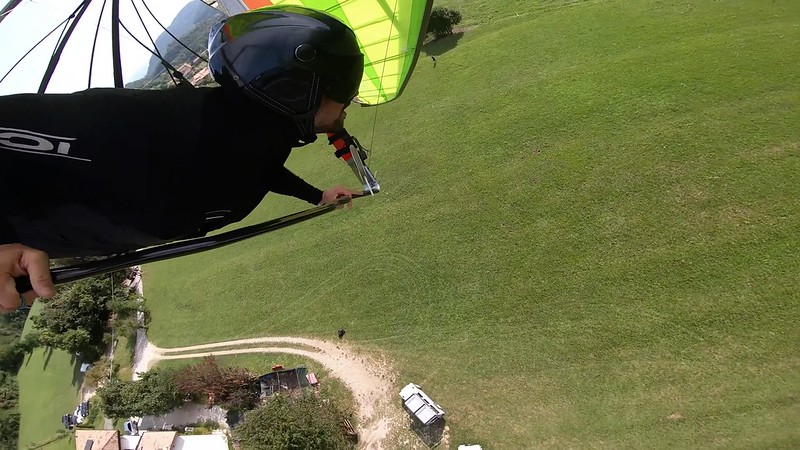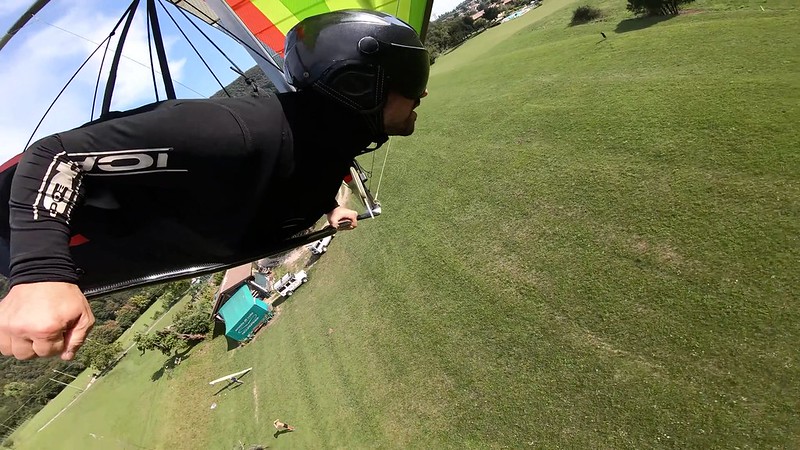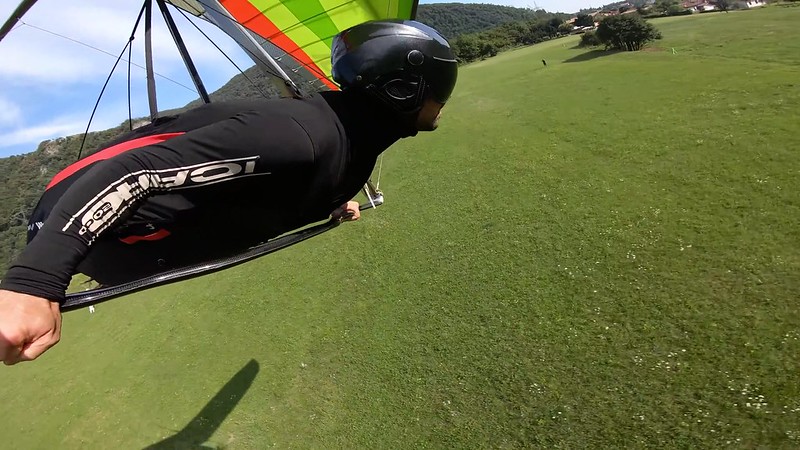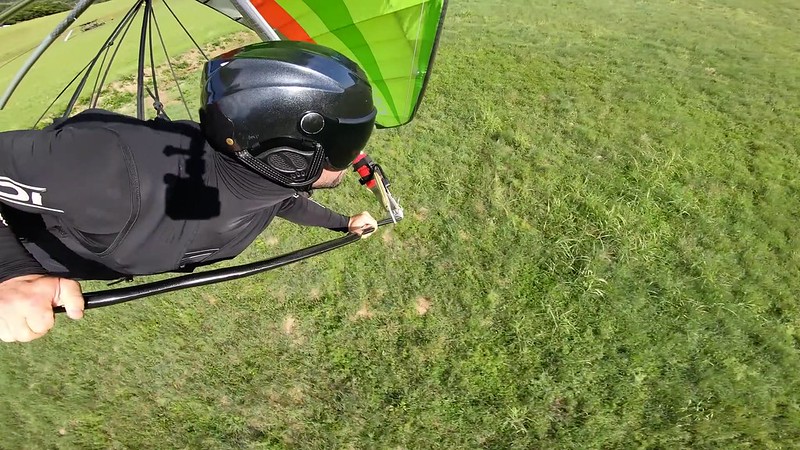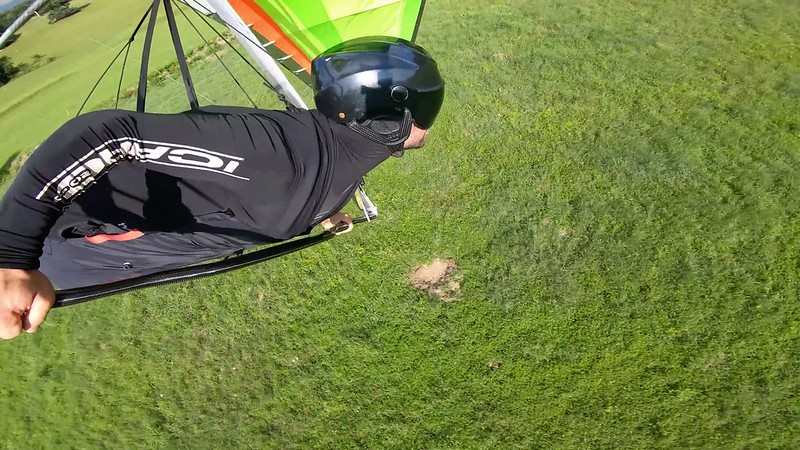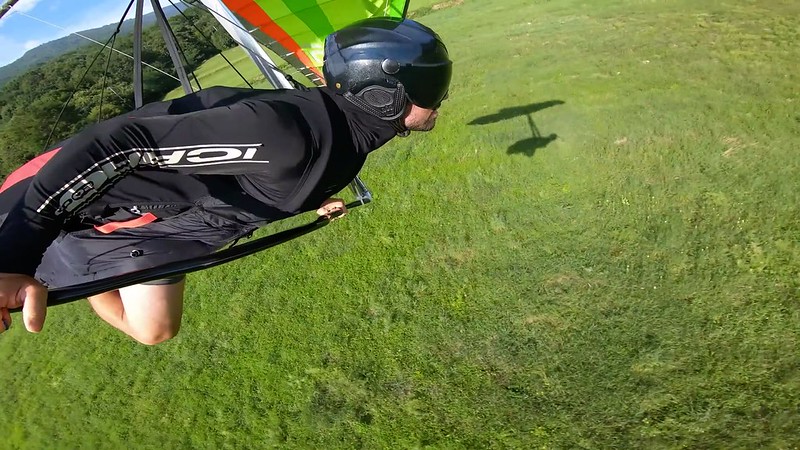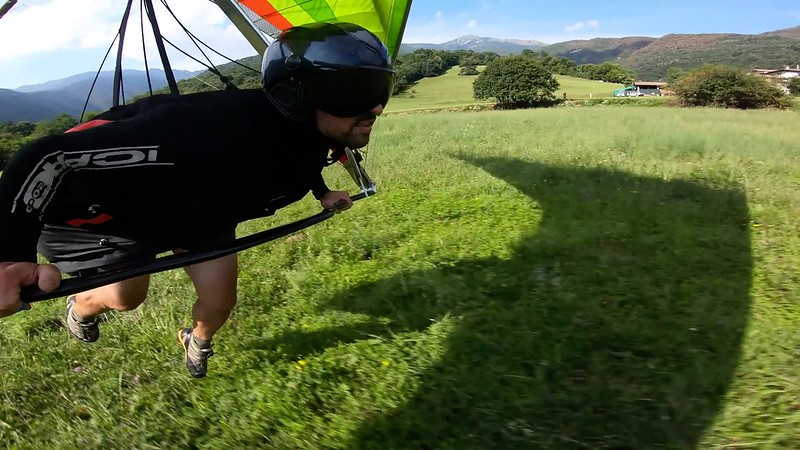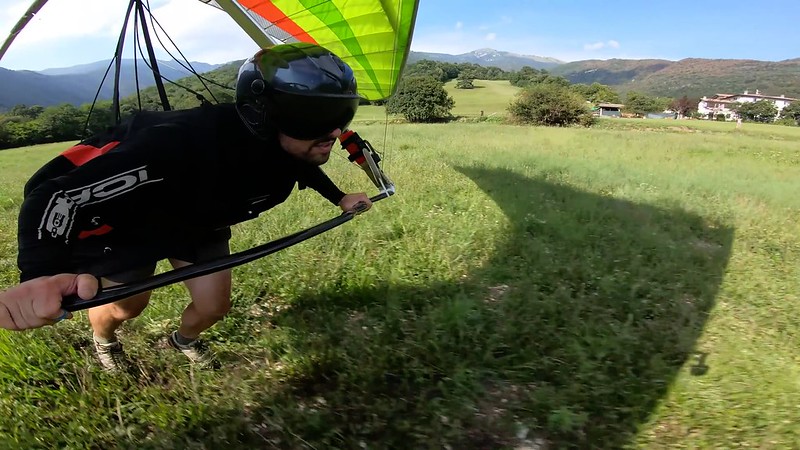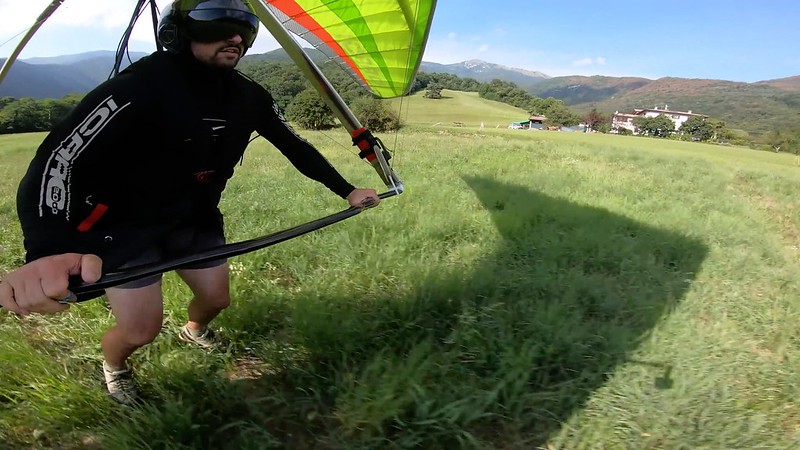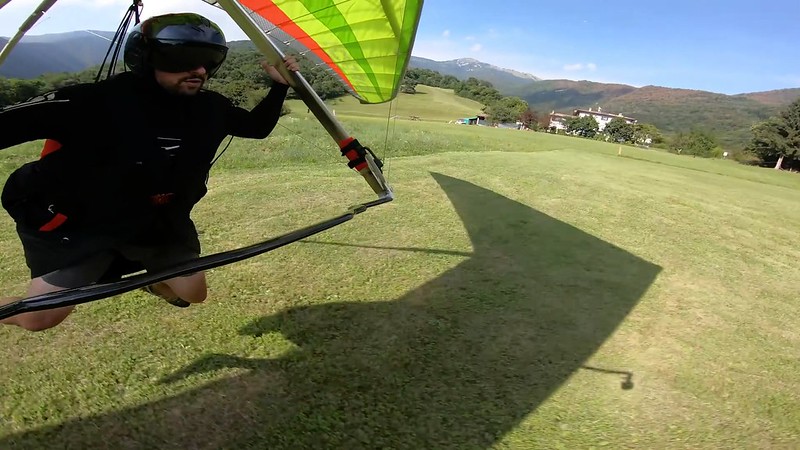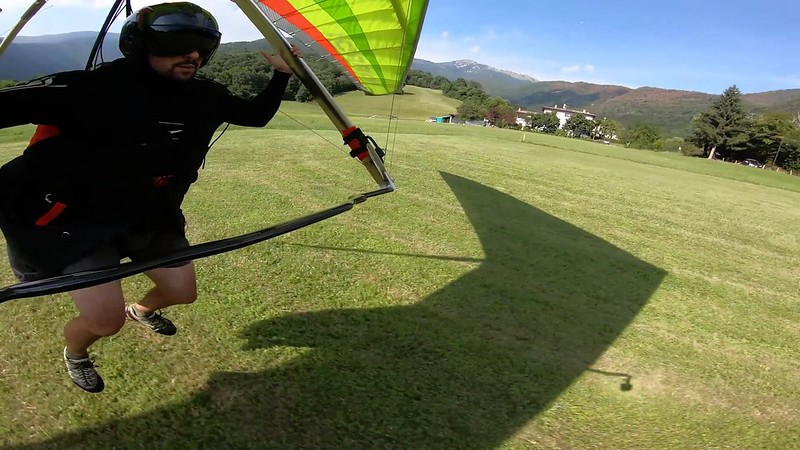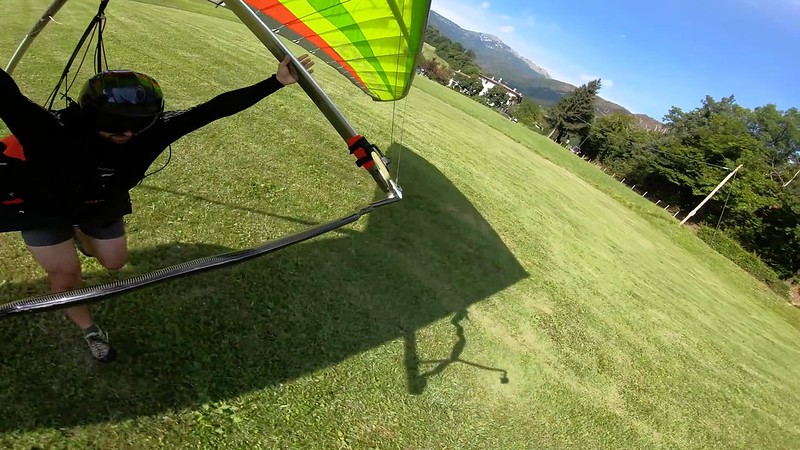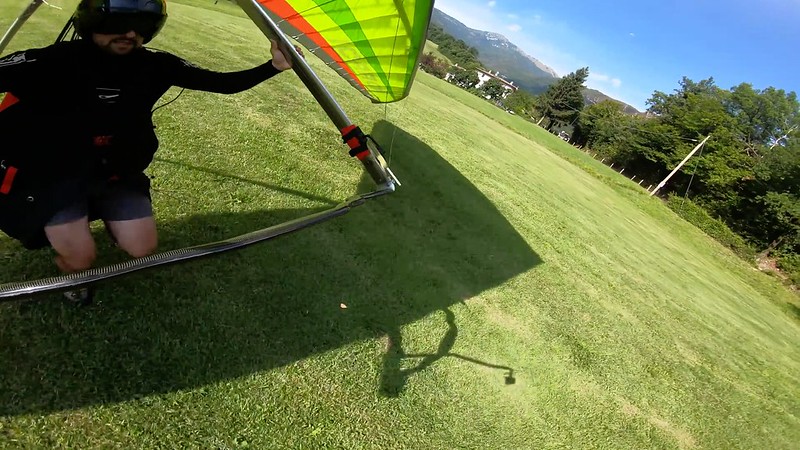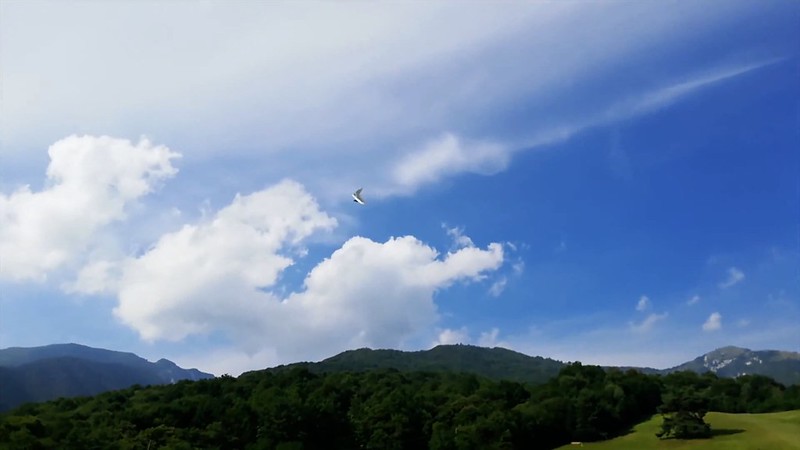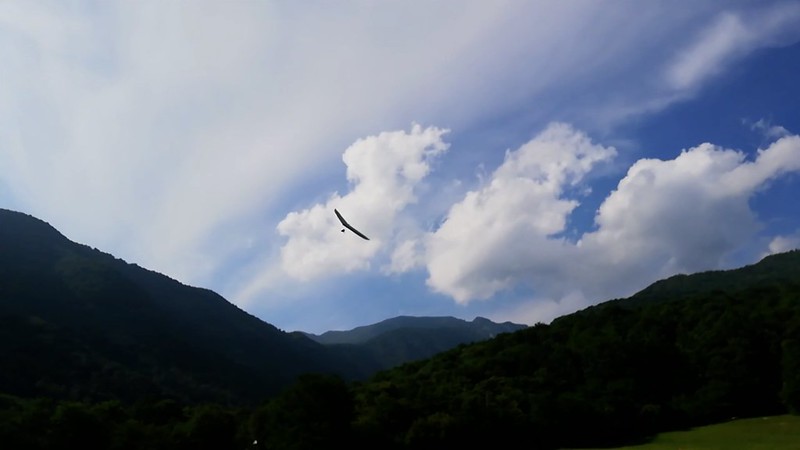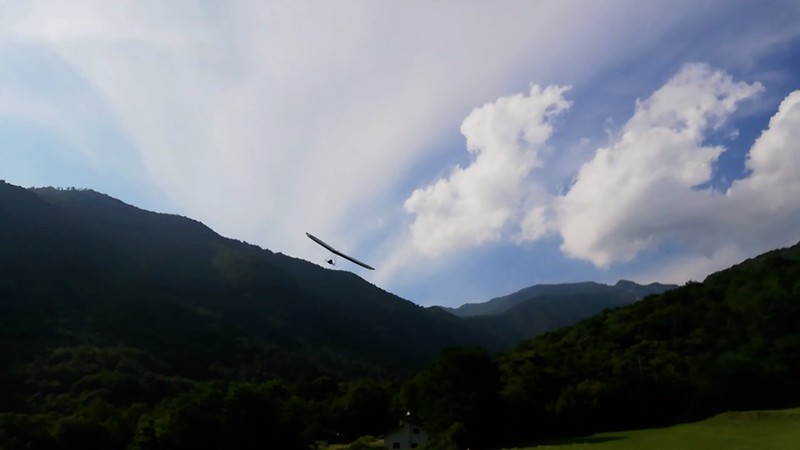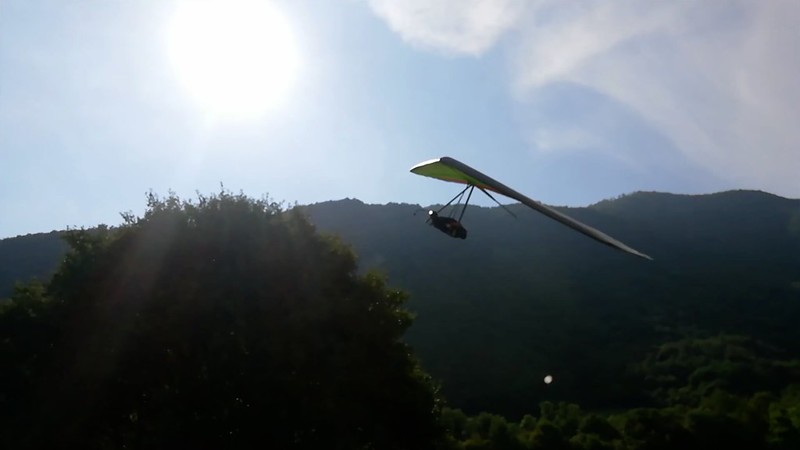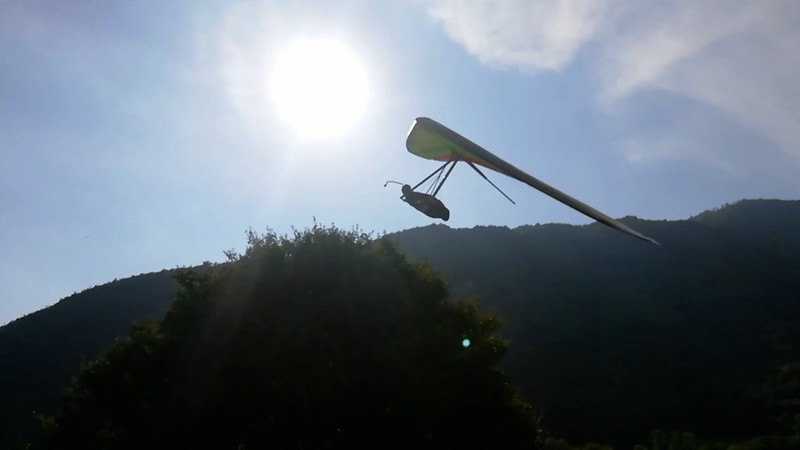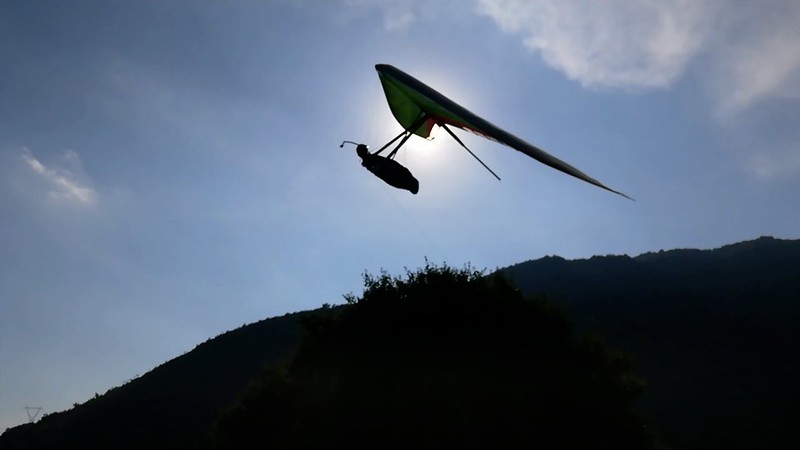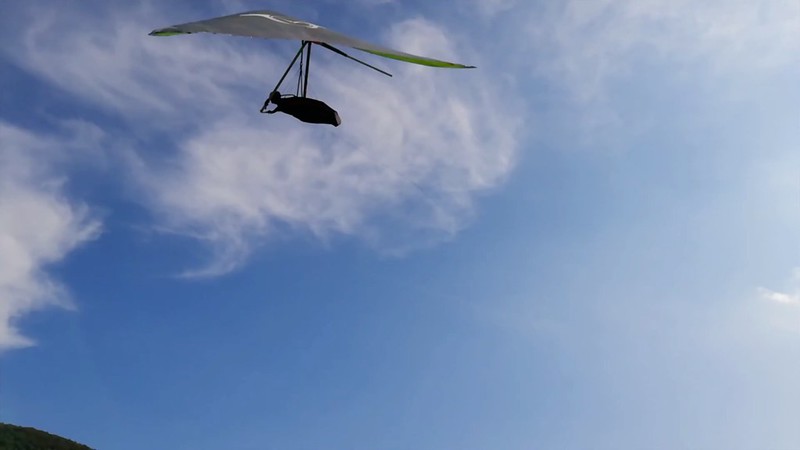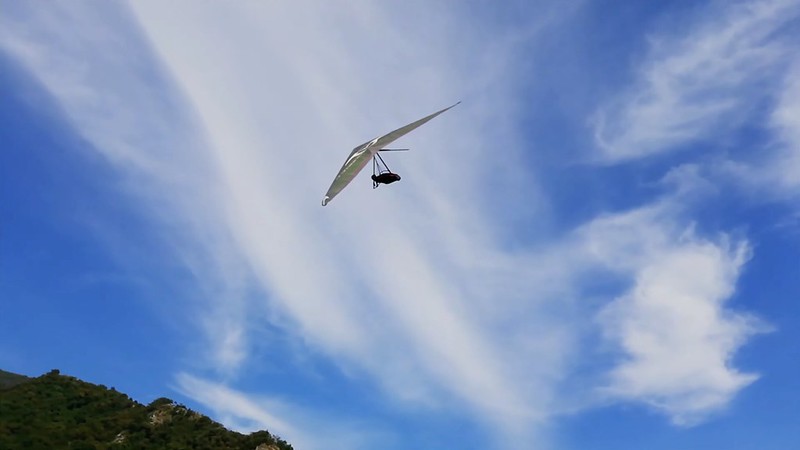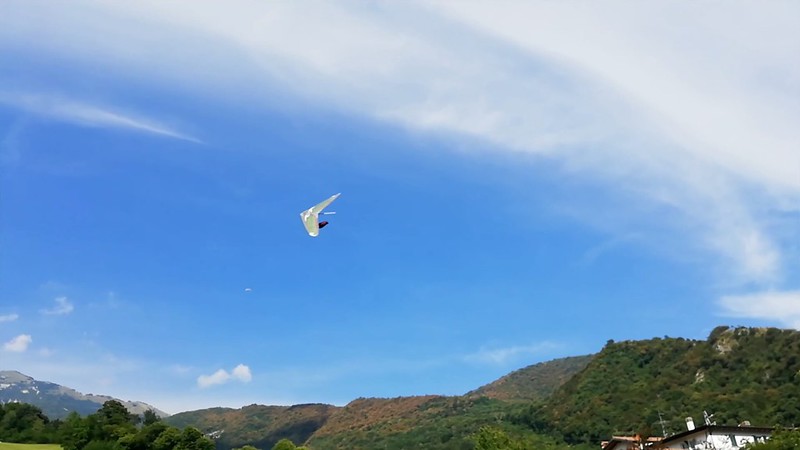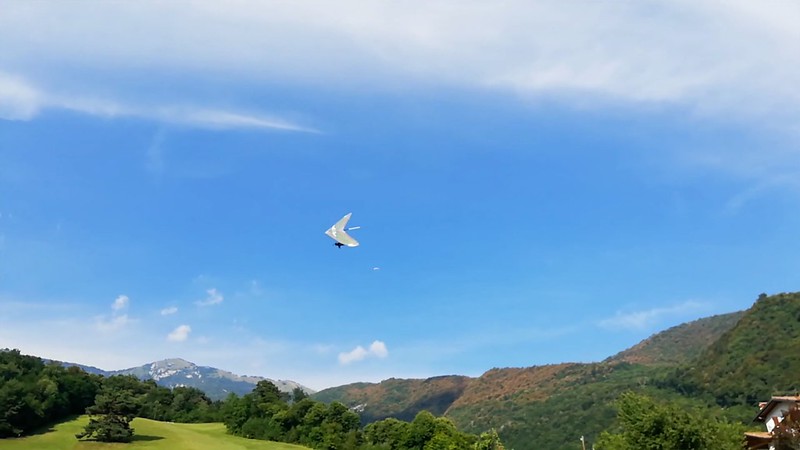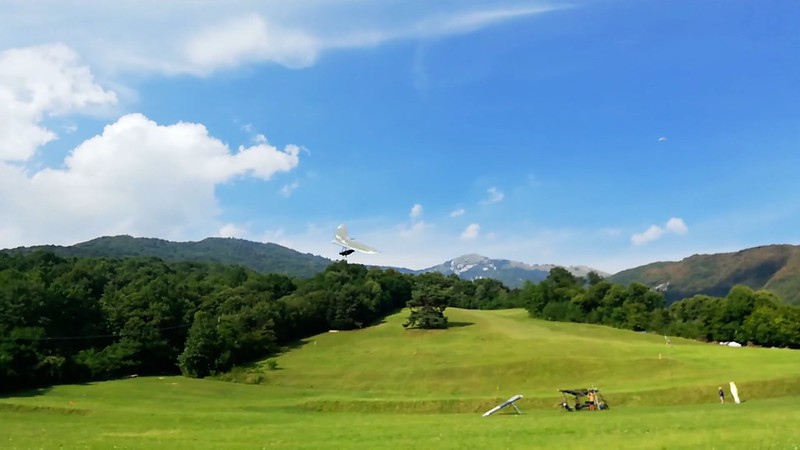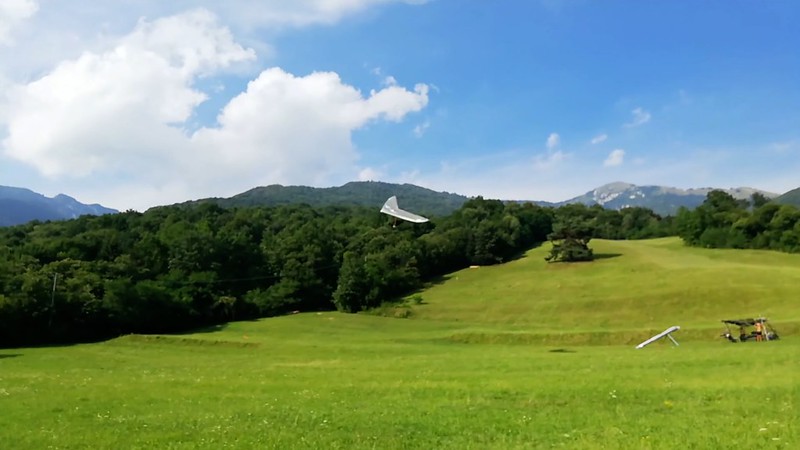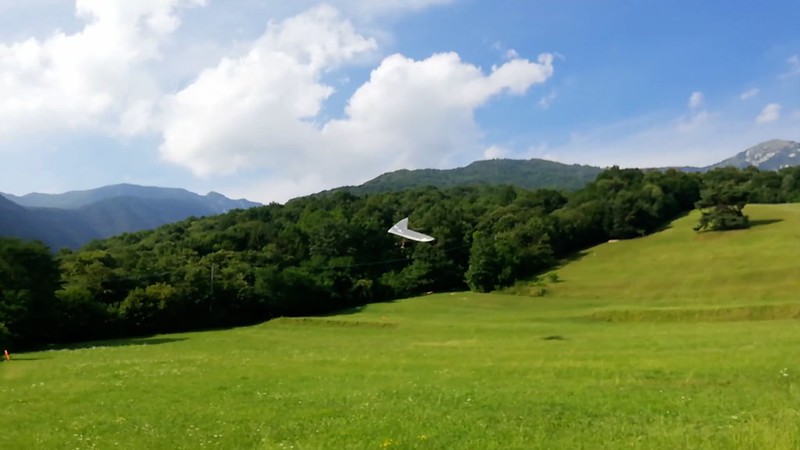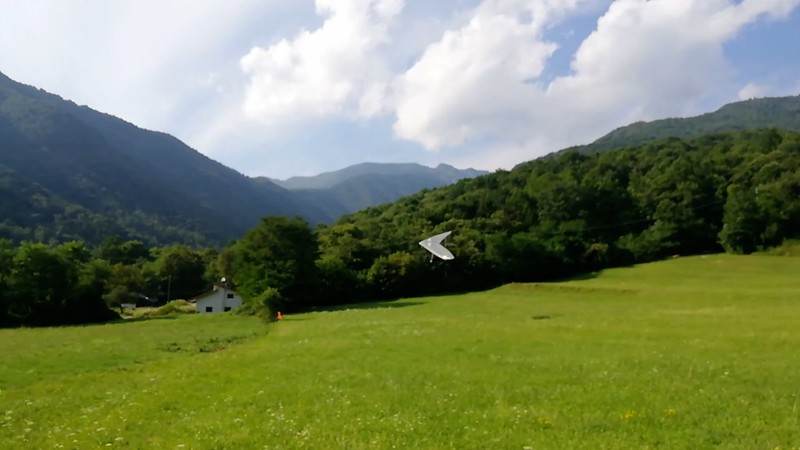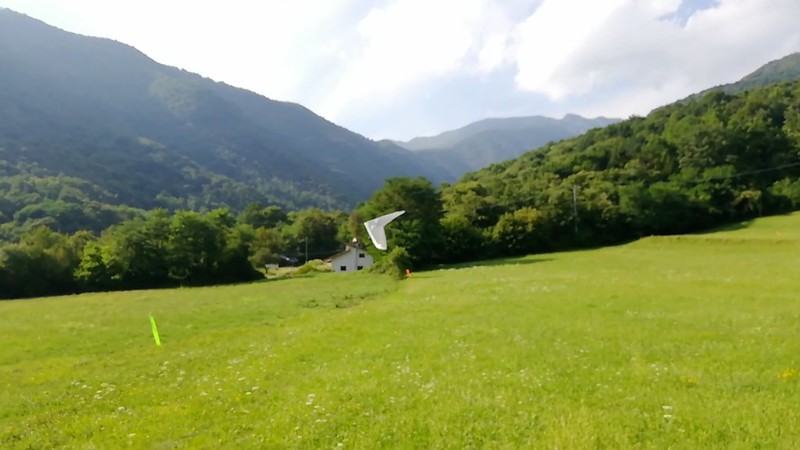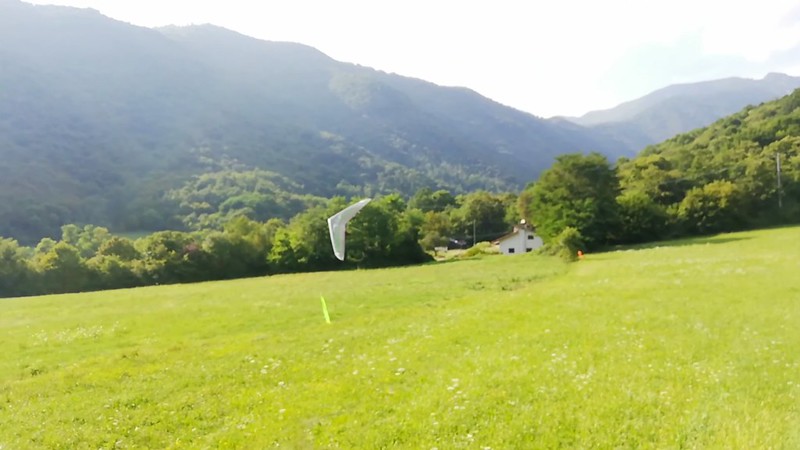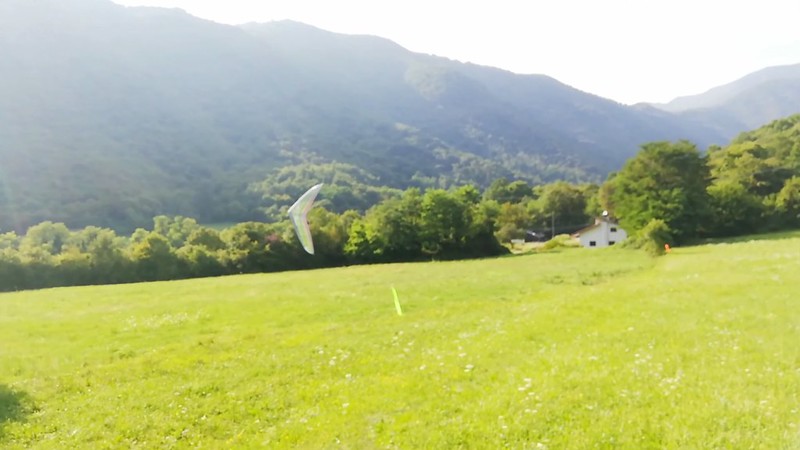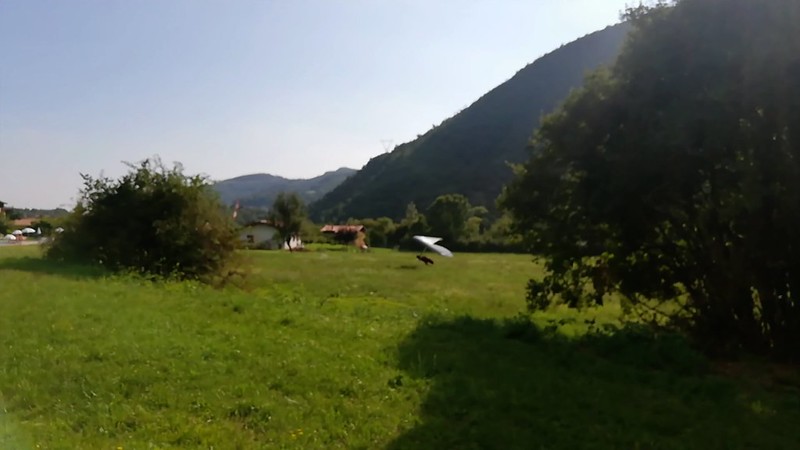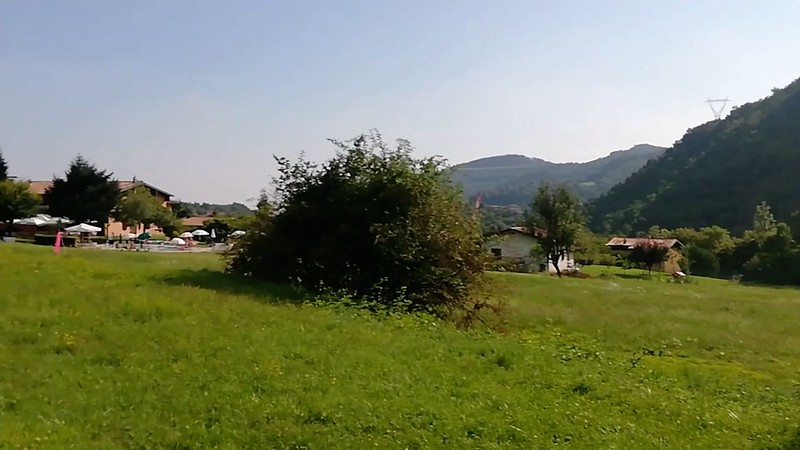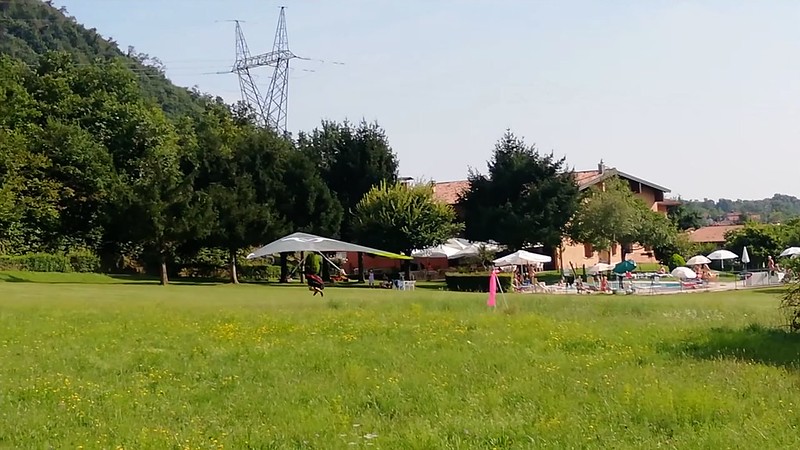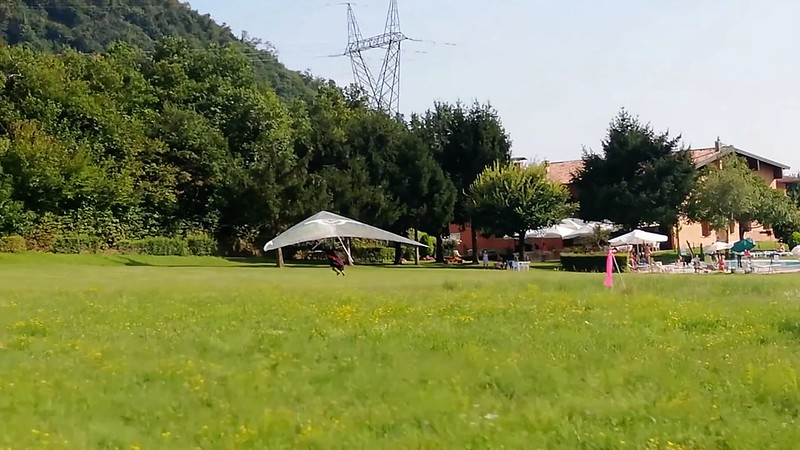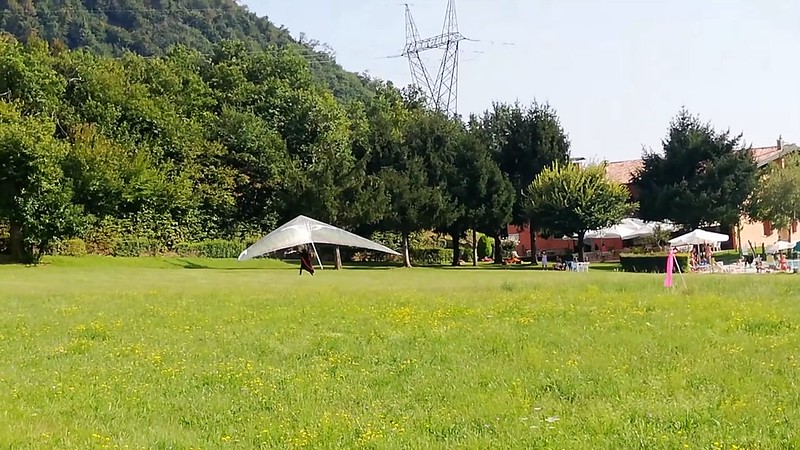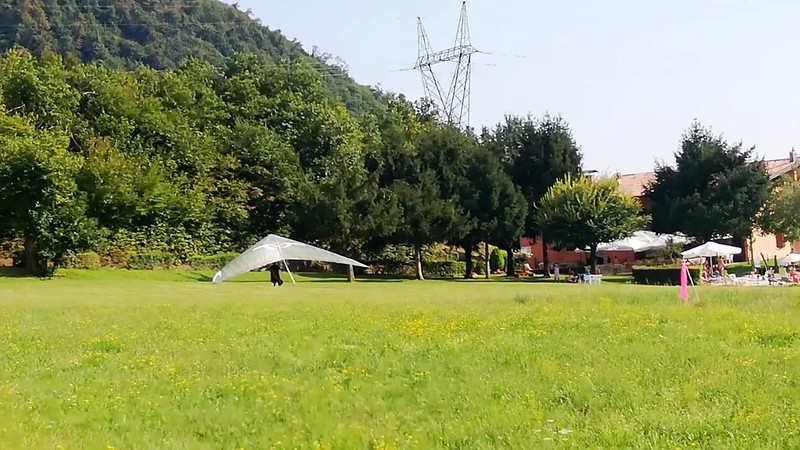http://ozreport.com/forum/viewtopic.php?t=63498
Rolling in on an ATOS
Wayne B. Ripley - 2020/09/16 19:16:50 UTC
wheel landings
In my mind the additional risk is in the foot landing not a wheel landing, when the wheels are the right size and the LZ is smooth I have never witnessed a bad landing, alternately I have witnessed near prefect conditions when a foot landing turned out to be disastrous, broken bones and broken gliders. Having both options and knowing how to execute both is a good way to extend your hang-gliding career.
Robert Moore - 2020/09/16 20:09:40 UTC
I've never personally witnessed a chute deployment, either, but I know it's something I don't want to do unless I have to. I try not to rely on safety equipment unless its really needed. My primary landing gear are my feet.
Brad Gryder - 2020/09/17 02:32:16 UTC
With one exception being coastal (beach) landings in laminar winds, most tandem pilots in normal environments prefer to wheel land due to its increased safety factor over foot landing.
The "normal environment" caveat means fields with short grass which may or may not include cow paddies. If an unexplored emergency field looks rocky, rough, or has tall grass or weeds that might grab the base bar, then the tandem pilot will probably attempt a foot landing, but normally he's looking for a good (low risk) field where he can execute a safe wheel landing for himself and his student.
The difference between the tandem pilot and the "wheels only" pilot who's never learned to foot land is that the tandem pilot has more options. He can choose to expose his less valuable legs to harmful terrain if the need arises, instead of always gambling with his face and neck. If the tandem pilot stays safe, then his student will also likely be safe.
Friends don't let wheel-landing friends fly years on end without offering to help them learn to foot land. Sooner or later they'll eat the rocks if they don't know how to get upright and flare right.
Robert Moore - 2020/09/17 03:21:16 UTC
...get upright and flare right.
That should be the able-bodied pilot's mantra!
Wayne B. Ripley - 2020/09/16 19:16:50 UTC
wheel landings
In my mind the additional risk is in the foot landing not a wheel landing...
Ya..
Gil Dodgen - 1995/01
All of this reminds me of a comment Mike Meier made when he was learning to fly sailplanes. He mentioned how easy it was to land a sailplane (with spoilers for glide-path control and wheels), and then said, "If other aircraft were as difficult to land as hang gliders no one would fly them."
...think?
...when the wheels are the right size...
Instead of tiny placebo jobs which may or may not do you any good in an actual routine landing situation?
...and the LZ is smooth...
An LZ is a designated site landing field. Name some that aren't smooth.
...I have never witnessed a bad landing...
They're all bad 'cause they're all face first. Just ask Joe Greblo and George Stebbins.
...alternately I have witnessed near prefect conditions when a foot landing turned out to be disastrous, broken bones and broken gliders.
1. Not to mention quads and kills.
2. But they're all setting themselves up for disaster 'cause they're not working on perfecting their flare timing for when they need to land in narrow dry riverbeds with large rocks strewn all over the place.
Having both options and knowing how to execute both is a good way to extend your hang-gliding career.
1. How much practice, experience, currency, judgment, skill - not to mention...
http://www.ushawks.org/forum/viewtopic.php?f=2&t=2095
Should we try a different way? Designwise....
Steve Corbin - 2015/09/02 22:26:04 UTC
Any un-biased observer should be able to see why wanna-be pilots find PG more attractive than HG. Standing around in the Andy Jackson Memorial International Airpark at a busy fly-in shows that a PG landing is a total non-event, while everyone stands up to watch HG's, piloted by "experts", come in to land. A good landing by a HG is greeted by cheers, an acknowledgement that landing one successfully is a demonstration not just of skill, but good luck as well.
...luck - is involved in a wheel landing?
2. There's no such thing as KNOWING how to execute a foot landing 'cause in real world conditions...
http://ozreport.com/forum/viewtopic.php?t=27086
Steve Pearson on landings
Steve Pearson - 2012/03/28 23:26:05 UTC
I can't control the glider in strong air with my hands at shoulder or ear height and I'd rather land on my belly with my hands on the basetube than get turned downwind.
...stopping safely on your feet is a total crap shoot. Ask Mitch Shipley for his advanced landing clinic, the one in which he sets his scooter tow rig in a narrow dry riverbed with large rocks strewn all over the place in gusty midday thermal conditions.
3. I KNOW how to execute a foot landing. And it took me decades to learn that one should never do one unless one's coming down into a strong smooth headwind with no substantial upwind obstructions - preferably at a coastal site.
Robert Moore - 2020/09/16 20:09:40 UTC
I've never personally witnessed a chute deployment, either, but I know it's something I don't want to do unless I have to.
Zack Marzec had to do one on his last flight but probably needed to initiate while he was still on tow. But if he was fuckin' clueless enough to fly pro toad with Rooney Link protection into a monster thermal shortly after launch he was obviously too fuckin' clueless to know that he needed to do it well before he finished rocketing up into whipstall mode.
I try not to rely on safety equipment unless its really needed.
Landing gear isn't SAFETY EQUIPMENT. Landing gear is something a COMPETENT PILOT will use for ever flight of his career. A parachute is emergency equipment that comes into play after we've exhausted all our piloting options. And with the rarest of exceptions a competent pilot will never get into a situation in which he needs to resort to using emergency equipment.
My primary landing gear are my feet.
So was Bill Vogel's.
http://www.flyatos.com/landing.htm
Landing the Atos
http://www.flyatos.com/bill_landing.jpg
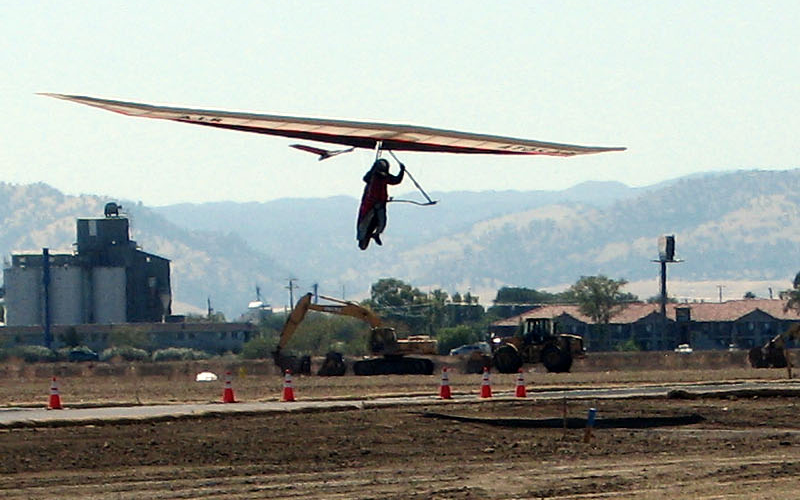
He was coming in slow and had zilch maneuvering speed and no option for stuffing the bar and diving under the wires.
http://www.hanggliding.org/viewtopic.php?t=13712
Very sad news
Vince Endter - 2009/09/20 20:38:57 UTC
I was the only witness to the accident. We had launched from Elk. Bill launched first, then Rich then me. We could not get higher than launch. We headed for the thistle field (the creek bed next to the thistle field). Bill was about 800' below me. He had set up to land between the two sets of wires crossing south of the thistle field. I radioed to him to watch out for the wires crossing the creek bed. He did not reply. He continued his approach to land in the upright position. It looked like he was at the same elevation as the wires when the finally saw them about 100' away and about 30' of altitude. He made a quick left hand turn, it looked like he was trying to make a 360. When he was 180 degrees through the turn his left hand tip hit a bush and his body impacted an 8' tall bank at the creek bed's edge.
He SHOULD have been able to pull that off if this report is reasonably accurate. And let's rewind and give it a go 'cause we can't make the outcome any worse.
Brad Gryder - 2020/09/17 02:32:16 UTC
With one exception being coastal (beach) landings in laminar winds, most tandem pilots in normal environments prefer to wheel land due to its increased safety factor over foot landing.
Why? 'Cause you can stay in certified configuration in
normal environments?
The "normal environment" caveat means fields with short grass which may or may not include cow paddies.
1. Name somebody who's ever sustained injury or damage due to a cow paddy while wheel landing.
2. If we include mature wheat in the category of tall grass Ridgely product Paul Vernon got permanently demolished by it on 2012/06/06.
If an unexplored emergency field looks rocky, rough, or has tall grass or weeds that might grab the base bar, then the tandem pilot will probably attempt a foot landing, but normally he's looking for a good (low risk) field where he can execute a safe wheel landing for himself and his student.
1. One wonders how sailplanes ever manage to manage.
2. Show me a video of a tandem ride coming down in something other than a Happy Acres putting green.
The difference between the tandem pilot and the "wheels only" pilot who's never learned to foot land is that the tandem pilot has more options.
WHAT?
- Virtually all tandem pilots operating as tandem pilots are "wheels only" pilots.
- NOBODY's EVER "LEARNED" to foot land 'cause foot landing in real world conditions is ALWAYS a CRAP SHOOT.
- There are no "wheels only" pilots who've never "learned to foot land save for people who came into the sport as paraplegics.
- We never hear about paraplegics and guys who become "wheels only" due to lower back issues having the slightest problems landing.
He can choose to expose his less valuable legs to harmful terrain if the need arises...
1. The need NEVER arises. Tandem operators would be sued out of existence after the first weekend if they put rides in situations in which they came down in foot only terrain.
2. Right. LEGS are what get injured in foot landing efforts. Arms, shoulders, necks, faces, heads always come out smelling like roses 'cause they're all way up out of harm's way.
...instead of always gambling with his face and neck.
Fuckin' moron.
If the tandem pilot stays safe, then his student will also likely be safe.
Yeah, Rob Richardson got killed. His "student" got of with a mere memory wiping concussion.
Friends don't let wheel-landing friends fly years on end without offering to help them learn to foot land.
1. If only we could find a friend who'd learned to foot land. (Anybody hear anything from Jim Keen-Intellect Rooney lately? I'm rather surprised that he's not participating in this thread - currently just five topics down from his Davis Show "Landings" sticky.
2. If Threes and Fours who are flying around racking up more airtime need HELP learning to foot land then foot landing is obviously something that can't be learned. And what's really interesting is that it as SUPPOSED TO HAVE BEEN "learned" for a One sign-off.
Sooner or later they'll eat the rocks if they don't know how to get upright and flare right.
1. Yep. Sooner or later - just a matter of time. Happens to EVERYBODY eventually. So we need to teach the pilot whose proven incapable of keeping a safe field in range how to execute a perfectly timed flare in his Plan B boulder field in whatever-the-hell conditions kicked in at the time.
2. Show me the incident report of this mythical Three who was unable to keep the LZ or a safe alternative in range?
3. Why won't they eat trees sooner or later? There's ALWAYS gonna be a narrow dry riverbed with large rocks strewn all over the place in range after the lose the primary?
Robert Moore - 2020/09/17 03:21:16 UTC
...get upright and flare right.
That should be the able-bodied pilot's mantra!
It is.

Obviously. And then when they're no longer able-bodied they're no longer pilots and we never hear from them again. Frank Sauber flew for over sixteen years before going scooter towing to learn to foot land so he could get his Three so he'd be able to land safely when he sooner or later had to come down in a narrow dry riverbed with large rocks strewn all over the place. And he locked out and got killed in the Taylor Farm Happy Acres putting green 'cause he didn't learn (and Santos Mendoza didn't teach him - now that I think of it) that in a crosswind he needed to let the glider drift downwind of the track to the pulley and point at the pulley / winch / boat / truck / tug.
But let's keep making 99 percent of our Jack and Davis Show threads and 99.99 percent of our instruction all about perfectly timed, positioned, executed foot landing flares. And don't worry about being challenged by anybody. You're coffee shop owners will step in to keep all the discussions friendly, positive, productive.
P.S. Did Bill Vogel survive his hang gliding career long enough to get himself in a position in which he need to get upright and flare right to avoid eating rocks. I'd have thunk that one of his friends would've mentioned that career landmark in the course of one of the postmortem discussions - 'specially what with the way that T** at K*** S****** asshole was in there so disrespectfully shooting his mouth off about how that situation might have been a lot more survivable...
http://www.hanggliding.org/viewtopic.php?t=13744
control
Jason Boehm - 2009/09/23 15:13:41 UTC
aerotow might have a point here
...if he'd stayed prone with his hands on the CONTROL bar.
P.P.S. Note absence of wheels/skids on the basetube in the photo above. That's definitely an able-bodied pilot who's learned how to get upright and flare right to avoid eating rocks. He'd have to have been totally wacko to come in like that if he hadn't.





